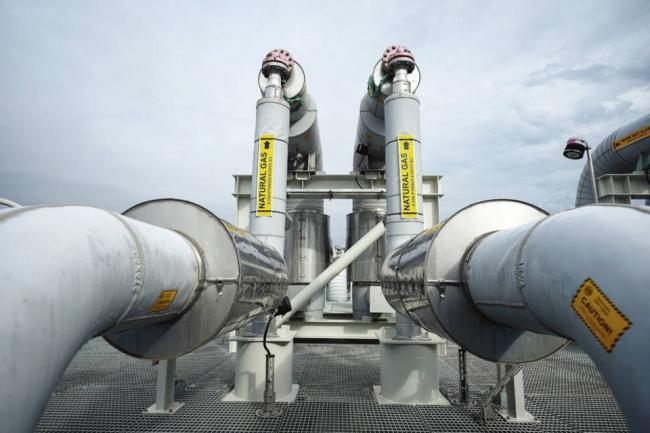For years, B.C. has called itself a climate leader. Now, the provincial climate plan is a shambles – and LNG expansion is set to make even inadequate targets unreachable.
B.C.’s latest Climate Change Accountability Report says the province will miss its 2030 pollution reduction target by 50%. This grim prediction does not account for climate pollution from future LNG terminals.
In December 2018, the B.C. government released its bold new plan to reduce climate pollution and build a low-carbon economy. The “CleanBC” plan promised a heightened level of ambition and a compelling vision for a future that prioritized investment in green technologies, clean electricity and decarbonization solutions.
Today, the provincial government admits it is badly off track to reach its own legislated pollution targets. And it has no plan to get there. Indeed, new pipelines (owned by American billionaires) and LNG terminals (built largely overseas) would vent even more planet-warming, health-harming gases into the atmosphere, at great cost to the B.C. public.
How did it all go so wrong? At one time, CleanBC was heralded as the strongest climate plan in North America. The government’s own press release boasted the names of two dozen prominent climate advocates and experts — including governors from California and Washington — all lauding B.C.’s climate leadership.
But three years after the release of CleanBC, recognizing government action was lagging, many experts who praised the original plan jointly published a scathing rebuke of B.C.’s progress. “We have lost the confidence we had in the province’s climate plan and are sounding the alarm,” they wrote.
Unfortunately, the situation has only become more dire since then.
Climate groups have been attempting to hold the government accountable for such failings with annual progress reports of their own. But this latest admission comes from the government’s own mouth: “B.C.’s current policy landscape does not put us on track to meet our 2030 targets,” the report states. The government blames this failure largely on entirely foreseeable population growth, while admitting that the biggest emissions increases came from commercial transport and fossil fuel production — not B.C. households.
Even so, the province claims reductions are coming, and that B.C. is charting a course in the right direction.
It is nearly impossible for this claim to come true.
First off, B.C.’s consumer carbon tax and rebate system is gone. Premier David Eby said the policy had become politically toxic. But scrapping the tax also meant losing out on the $3 billion in revenue it collected annually, revenue used to issue “climate action” cheques to households and fund rebates for heat pumps and electric cars — rebates that are now on the chopping block.
Perhaps even more concerning is the glaring omission of LNG in this latest Climate Change Accountability Report. In the 43-page document, LNG is mentioned only once. This omission is mindboggling considering the province is caught in a frenzy to become a major LNG exporter. B.C. will begin shipping the highly polluting fossil fuel this summer when LNG Canada begins operating in Kitimat.
Cedar LNG (a floating LNG facility under construction in Korea) and Woodfibre LNG (another foreign-owned export facility in Squamish) are next in line, with three more export facilities now approved or under review. A massive American-backed pipeline in northern B.C. — the Prince Rupert Gas Transmission Line — is also awaiting approval.
If B.C. moves ahead with all these new fossil fuel projects, it will increase climate pollution not just in B.C. where the gas is extracted and processed, but around the world. Shipping 47 million tons of LNG overseas every year (as these projects would collectively do) would produce 125 million tons of carbon pollution when the fuel is burned (an amount more than double B.C.’s current total domestic emissions) and have significant local health impacts on the communities where the gas is fracked.
Many of these projects are not only backed or funded by American private equity giants with direct ties to U.S. President Donald Trump, but also face opposition from First Nations who stand to experience the largest impacts of these projects in their own backyards.
The province is disregarding the wishes of First Nations people who see what is happening on the ground and want to protect the land and water in their territories. Many First Nation communities are finding innovative ways to respond to the climate crisis that involve restoring our relationship to the world around us. Instead of supporting these communities, B.C. wants to fast-track more projects for the oil and gas industry.
B.C.’s plan also leans on carbon capture and storage — a well-known false solution — and encourages “industrial facilities to connect to clean electricity.” Even this requirement is now being scaled back, however, as B.C.’s Minister of Energy and Climate Solutions Adrian Dix recently loosened the rules for proposed LNG projects.
Under all these conditions, it is impossible for B.C. to meet its climate targets. Failing to truly bend the curve on our pollution is not only a broken political imperative, it is also a failure to protect the health of British Columbians. It is a failure to preserve our most precious natural resources — clean water and clean air — and to acknowledge the voices of First Nations people when it comes to the health of the land.
In 2018, B.C. had a shiny new climate plan. Not anymore. What remains of the CleanBC program is a shambles. If a “plan” means having appropriate targets and a credible pathway to attain such targets, then the sad truth is that B.C. no longer has a climate plan.
The B.C. government must present something new and ambitious to take its place.
Grand Chief Stewart Phillip is president of the Union of B.C. Indian Chiefs. Dr. Melissa Lem is president of the Canadian Association of Physicians for the Environment. Kai Nagata is communications director with Dogwood B.C. Emiko Newman is co-ordinator of the B.C. Climate Emergency Campaign. Tracey Saxby is a marine scientist and co-founder of My Sea to Sky. Kiki Wood is a senior oil and gas campaigner with Stand.earth.
[Top photo: Piping on the top of a receiving platform for the Coastal GasLink natural gas pipeline terminus at the LNG Canada export terminal in Kitimat. DARRYL DYCK, THE CANADIAN PRESS]

